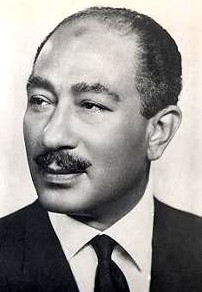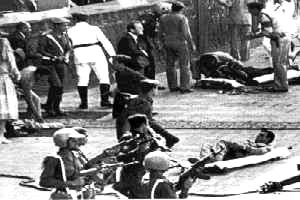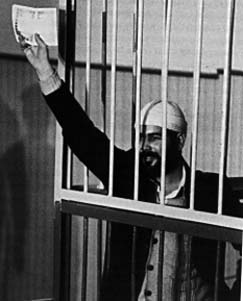|
Egyptian Islamic Jihadaka al-Jihad Egypt has been home to rabble-rousers and troublemakers since the days of Moses.
Egypt has been home to rabble-rousers and troublemakers since the days of Moses. But while Moses had frogs, boils, locusts and baby-killing angels at his disposal, Egyptian Islamic Jihad only has guns, knives and explosives to work with. They've made the most of their tools. EIJ is perhaps the most overtly successful terrorist operation in history. An offshoot of the Muslim Brotherhood, EIJ splintered off in the early 1970s as a student-oriented rebellion against the right-wing military dictatorship run by former Nazi spy Anwar Sadat. The members of Egyptian Islamic Jihad are Sunni Islamic fundamentalists who want to overthrow Egypt's secular government and replace it with a Taliban-style theocracy. Affiliated groups include Gama'a al-Islamiyah (aka Jamaat al-Islamiyya) al-Jihad. By paying lip service to nonviolence, the Muslim Brotherhood began to push for mainstream political acceptance, while EIJ acted as its "covert-overt" militant arm, along with several other groups. Although the Brotherhood denied any tie to the actions of EIJ and groups like al-Jihad, journalists and the Egyptian government believe the Brotherhood calls the shots when it comes to terrorist attacks in Egypt.
Sadat's assassins were connected to the Brotherhood, EIJ and Gama'a al-Islamiyah, via radical Sheikh Omar Abdel Rahman, a blind cleric who doubles as "spiritual leader" for both groups. "The Blind Sheikh," who was later tied to the 1993 World Trade Center bombing, reputedly pronounced a fatwa approving the assassination. (He was suspected of a similar role in the WTC attack.) Abdel-Rahman stood trial alongside the Sadat triggermen, but he was acquitted.
In the mid-1980s, Zawahiri took over EIJ. A member of the ultraviolent Al Takfir Wal Hijra sect, Zawahiri led Egyptian Islamic Jihad to new levels of global accomplishment. Shortly after Zawahiri took the reins, EIJ went international. A handful of Egyptian terrorists came to the U.S. and created sleeper cells which were eventually tied back to Egyptian Islamic Jihad and the still young al Qaeda. One member of this group, Ali Mohammed, even joined the U.S. Special Forces, where he served as a sergeant. Another, Mahmud Abouhalima, moved to New York City and joined the NRA. El Sayyid Nosair, an Egyptian militant associated with the cell, shot and killed a right-wing rabbi named Meir Kahane in 1990. The advance team moved to key locations and began setting up networks for moving money and weapons around the U.S. and overseas. The U.S. government looked the other way while this was happening, since the team's efforts were largely directed toward fighting the Soviet Union in Afghanistan, where the CIA was running a proxy war on behalf of the U.S. using a volunteer army made up of Islamic extremists.
Al Qaeda and Egyptian Islamic Jihad operatives cooperated extensively to pull off the 1993 WTC attack, in which Ramzi Yousef worked closely with followers of the blind sheikh in Brooklyn. In 1995, Zawahiri came to the U.S. for a fundraising visit. While in California, he stayed with Ali Mohammed, who by then had become bin Laden's chief of security. Regardless of exactly when the alliance formally took place, Egyptian Islamic Jihad is today considered to be a regional adjunct of al Qaeda, a branch office in Egypt, much like Jemaah Islamiah in Southeast Asia. Zawahiri himself is now considered to be the No. 2 figure in al Qaeda, after bin Laden. In most meaningful respects, he's probably more like the No. 1 figure in al Qaeda, although bin Laden is the visible outer head of the organization.
But since the mid 1990s, the organization has increasingly focused its attention overseas and its efforts have been largely indistinguishable from those of al Qaeda. It may not be so much Egyptian any more, but the Islamic Jihad goes on... and on... and on... After Zawahiri, probably the most famous member of Egyptian Islamic Jihad is Mohammed Atta, who flew an airplane into the World Trade Center on September 11. EIJ is also believed to be responsible for the 1998 bombing of U.S. embassies in Kenya and Tanzania, an attack which led to the historic "U.S. vs. bin Laden," the criminal case that first brought bin Laden's name out of the shadows and into the headlines. Zawahiri's pal Ali Mohammed was a key suspect in this case, and he cut a plea deal in which he provided information in exchange for a sentence which is still under seal. His current whereabouts are one of the great "national security" secrets of the day...
|
 And there have been an awful lot of terrorist attacks in Egypt. Egyptian Islamic Jihad and other domestic groups have distinguished themselves in both ambition and sheer bloodiness. In 1981, EIJ and other affiliated groups changed the course of Middle Eastern history by assassinating Sadat, who had been attempting to negotiate peace with Israel.
And there have been an awful lot of terrorist attacks in Egypt. Egyptian Islamic Jihad and other domestic groups have distinguished themselves in both ambition and sheer bloodiness. In 1981, EIJ and other affiliated groups changed the course of Middle Eastern history by assassinating Sadat, who had been attempting to negotiate peace with Israel. 
 At some point, EIJ became formally consolidated with al Qaeda, after Zawahiri and
At some point, EIJ became formally consolidated with al Qaeda, after Zawahiri and  Despite its status as a satellite to al Qaeda, Egyptian Islamic Jihad is far from irrelevant, however. Before hooking up with al Qaeda, EIJ mostly targeted political leaders and military figures, rather than random civilians. The group has tried to assassinate Egyptian president Hosni Mubarek on more than one occasion, including at least one effort directly tied to al Qaeda. EIJ has also tried to kill various lesser officials in the Egyptian government.
Despite its status as a satellite to al Qaeda, Egyptian Islamic Jihad is far from irrelevant, however. Before hooking up with al Qaeda, EIJ mostly targeted political leaders and military figures, rather than random civilians. The group has tried to assassinate Egyptian president Hosni Mubarek on more than one occasion, including at least one effort directly tied to al Qaeda. EIJ has also tried to kill various lesser officials in the Egyptian government.